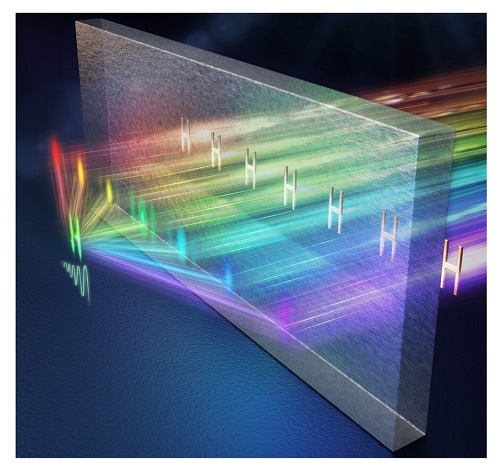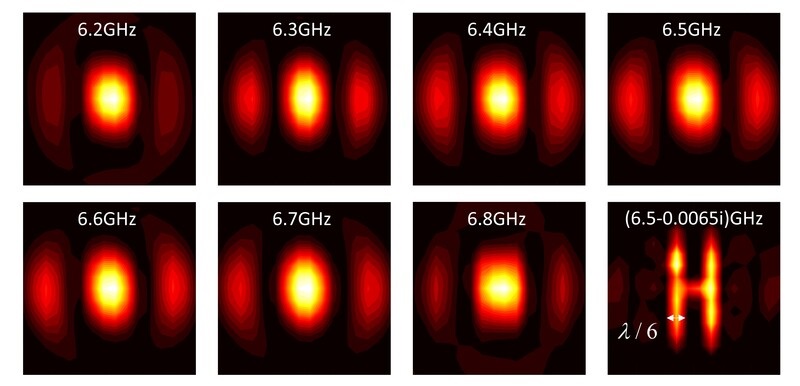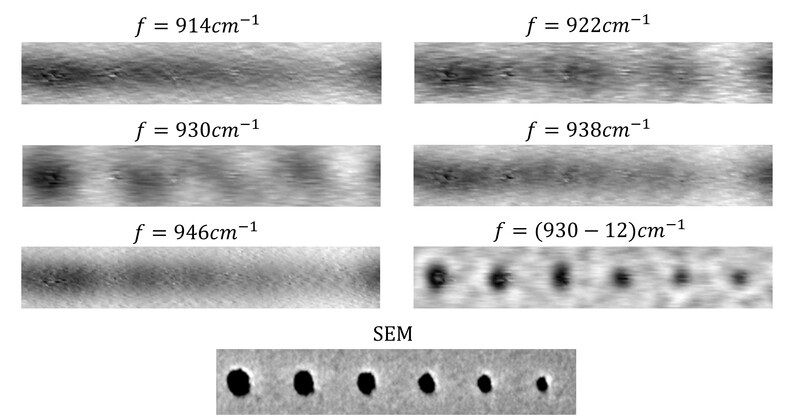
Complex Frequency Waves Counter Optical Losses in Superimaging
Superlenses made of plasmonic materials and metamaterials can image features at the subdiffraction scale. However, intrinsic losses restrict the image resolution of superlenses, hindering their widespread use.
To compensate for optical loss in superimaging systems, researchers at the University of Hong Kong (HKU) devised a way to provide virtual gain. To do so, they synthesized excitation waves of complex frequency, based on measurements at real frequencies. By illuminating materials with synthetic frequency waves, the researchers were able to implement virtual gain experimentally and retrieve subwavelength features. The multifrequency approach from HKU could provide a practical solution to overcoming the intrinsic losses of plasmonic systems used for imaging, sensing, and nanophotonic circuits.

Schematic of imaging under real-frequency and synthesized complex frequency excitation in a superlens. Courtesy of HKU.
The team determined that complex frequency waves could not be physical, or they would diverge when time went to either positive or negative infinity. Therefore, any realistic implementation of complex frequency waves would need to be truncated in time to avoid the divergence.
The team used Fourier transform, a mathematical formula that changes a signal or pattern from its time or space representation to its frequency, to break down a truncated complex frequency wave into multiple components of different real frequencies. This allowed the researchers to implement complex frequency waves for various applications, including superimaging.
The researchers performed optical measurements at multiple real frequencies at fixed intervals and were able to construct the optical response of a system at a complex frequency by mathematically combining the measurements of the real frequencies.
Using the multifrequency approach, the researchers implemented virtual gain experimentally and observed deep-subwavelength images.

Electric field profile of waves in (a) real frequency, (b) complex frequency, and (c) truncated complex frequency. (d) Truncated complex frequency wave synthesized by the linear combination of multiple real frequencies. Courtesy of HKU.
“To solve the optical loss problem in some important applications, we have proposed a practical solution, using a novel synthetic complex wave excitation to obtain virtual gain and then offset the intrinsic loss of the optical system,” professor Shuang Zhang said. “As a verification, we applied this approach to the superlens imaging mechanism and theoretically improved imaging resolution significantly.”
The researchers performed superimaging at microwave frequencies using a hyperbolic metamaterial, and polariton metamaterials in the optical frequency range, said researcher Fuxin Guan. “As expected, we obtained excellent imaging results consistent with our theoretical predictions.”
Hyperbolic metamaterial can carry waves with very large wavevectors that can transmit the information of very small feature sizes. However, the larger the wavevector, the more sensitive the waves are to optical loss. Therefore, in the presence of loss, the information of the small feature sizes gets lost during propagation inside the hyperbolic metamaterial. The researchers showed that, by appropriately combining the blurred images measured at different real frequencies, a clear image at a complex frequency could be formed with deep-subwavelength resolution.

Imaging patterns in multiple real frequencies and complex frequency of the letter H. Courtesy of HKU.
To demonstrate the multifrequency approach with optical frequencies, the team used its technique with an optical superlens made of silicon carbide (SiC) phononic crystal operating at the far-infrared wavelength of around 10 μm.
In a phononic crystal, the lattice vibration can couple with light to create a superimaging effect. However, loss is still a limiting factor in the spatial resolution. The researchers showed that, although the spatial resolution was limited by loss at all the real frequencies, ultrahigh-resolution imaging could be obtained with synthetic complex frequency waves consisting of multiple frequency components.

Superimaging using an SiC superlens operating at optical frequency. Complex frequency measurement provides a much better spatial resolution than that of a real frequency. Scanning electron microscope image shows the object performance. Courtesy of HKU.
“The work has provided a solution to overcome optical loss in optical systems, a long-standing problem in nanophotonics,” professor Xiang Zhang said. “The synthesized complex-frequency method can be readily extended to other applications, including molecular sensing and nanophotonic integrated circuits.”
Zhang said that the multifrequency approach was universally applicable and could be leveraged to tackle loss in other wave systems, including sound waves, elastic waves, and quantum waves, elevating imaging quality to a new height.
The research was published in Science (www.science.org/doi/10.1126/science.adi1267).
Published: September 2023